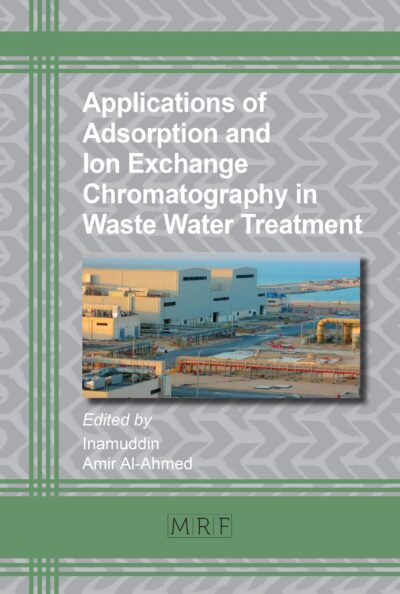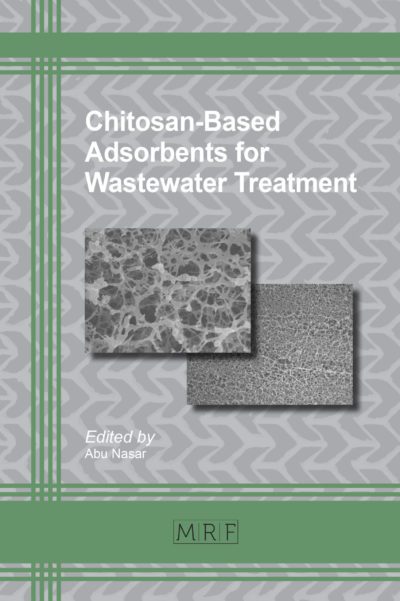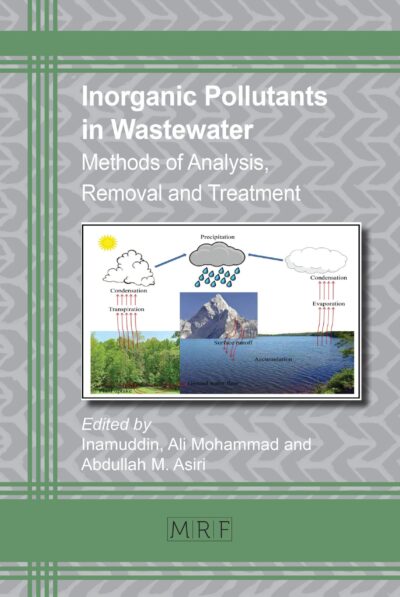Molecular screening of metal oxides for arsenic removal from water
NOOR E Hira, SERENE Sow Mun Lock, KHADIJA Asif, FARMAN Ullah, ABID Salam Farooqi
download PDFAbstract. Toxic metal arsenic in the ground water is poisonous and harmful that should be treated to ensure human health and safety. For many years, different technologies have been developed for the treatment of contaminated water and adsorption is an economical method in which a large number of adsorbents are being used including metal oxides. The selection of these metal oxides needs to be done systematically to choose the best metal oxide with good potential for arsenic removal from water. Previous work has been mostly focused on experimental study, which is time-consuming and expensive. Only a limited number of simulation study has been conducted, which is confined to only several specific adsorbents, such as oxides of iron. There is a need to do research for other metal oxides to evaluate which one is more capable of removing arsenic from water. In this research work, screening of metal oxides was done using Molecular Dynamics and Monte Carlo Simulation. The molecular structures were optimized and sorption calculations were performed at fixed pressure of 100kPa and temperature of 298K to observe the adsorption capability of metal oxides. Al2O3 and SnO2 were found to be good adsorbent for arsenic removal from water with adsorption capacity of 1681.80 g/g and 975.03 g/g respectively. Previously used Al2O3 was used as a benchmark for this research and adsorption capacity results also proved it. It was observed that SnO2 has potential to remove arsenic from water with adsorption capacity 975.03 g/g. The results displayed that SnO2 can be one of the best adsorbents for application of arsenic removal from water. It is concluded that apart from using conventional metal oxides for arsenic removal, other metal oxides should be studied and can also be used as an adsorbent as they can provide great adsorption capacity for arsenic removal from water.
Keywords
Water Treatment, Adsorption, Arsenic, Monte Carlo Simulation, Metal Oxides
Published online 5/20/2023, 8 pages
Copyright © 2023 by the author(s)
Published under license by Materials Research Forum LLC., Millersville PA, USA
Citation: NOOR E Hira, SERENE Sow Mun Lock, KHADIJA Asif, FARMAN Ullah, ABID Salam Farooqi, Molecular screening of metal oxides for arsenic removal from water, Materials Research Proceedings, Vol. 29, pp 201-208, 2023
DOI: https://doi.org/10.21741/9781644902516-23
The article was published as article 23 of the book Sustainable Processes and Clean Energy Transition
![]() Content from this work may be used under the terms of the Creative Commons Attribution 3.0 license. Any further distribution of this work must maintain attribution to the author(s) and the title of the work, journal citation and DOI.
Content from this work may be used under the terms of the Creative Commons Attribution 3.0 license. Any further distribution of this work must maintain attribution to the author(s) and the title of the work, journal citation and DOI.
References
[1] C. Hewitson, “Water,” Water, vol. 5, no. July, pp. 1–68, 2013, https://doi.org/10.4324/9780203769287
[2] and Á. I. A. Arruti, I. Fernández-Olmo, “Evaluation of the contribution of local sources to trace metals levels in urban PM2.5 and PM10 in the Cantabria region (Northern Spain),” J. Environ. Monit., vol. 12, no. 7, pp. 1451–1458.
[3] P. Kavcar, A. Sofuoglu, and S. C. Sofuoglu, “A health risk assessment for exposure to trace metals via drinking water ingestion pathway,” Int. J. Hyg. Environ. Health, vol. 212, no. 2, pp. 216–227, 2009, https://doi.org/10.1016/j.ijheh.2008.05.002
[4] F. T. Mackenzie, R. J. Lantzy, and V. Paterson, “Global trace metal cycles and predictions,” J. Int. Assoc. Math. Geol., vol. 11, no. 2, pp. 99–142, Apr. 1979.
[5] S. De Gisi, G. Lofrano, M. Grassi, and M. Notarnicola, “Characteristics and adsorption capacities of low-cost sorbents for wastewater treatment: A review,” Sustain. Mater. Technol., vol. 9, pp. 10–40, 2016, https://doi.org/10.1016/j.susmat.2016.06.002
[6] L. Chen et al., “Application of metal oxide heterostructures in arsenic removal from contaminated water,” J. Nanomater., vol. 2014, 2014, https://doi.org/10.1155/2014/793610
[7] J. H. Gulledge and J. T. O’Connor, “Removal of arsenic (V) from water by adsorption on aluminum and ferric hydroxides,” J. / Am. Water Work. Assoc., vol. 65, no. 8, pp. 548–552, 1973, https://doi.org/10.1002/j.1551-8833.1973.tb01893.x
[8] M. Gallegos-Garcia, K. Ramírez-Muñiz, and S. Song, “Arsenic removal from water by adsorption using iron oxide minerals as adsorbents: A review,” Mineral Processing and Extractive Metallurgy Review, vol. 33, no. 5, pp. 301–315, 2012, https://doi.org/10.1080/08827508.2011.584219
[9] Youngran Jeong, Maohong Fan, Shilpi Singh, Chia-Line Chuang, Basudeb Saha, J. Hans van Leeuwen, Evaluation of iron oxide and aluminum oxide as potential arsenic(V) adsorbents, Chemical Engineering and Processing – Process Intensification, Volume 46, Issue 10,2007
[10] S.S.M. Lock, K.K. Lau, A.M. Shariff, Y.F. Yeong, M.A. Bustam, Norwahyu Jusoh, Faizan Ahmad, An atomistic simulation towards elucidation of operating temperature effect in CO2 swelling of polysulfone polymeric membranes,Journal of Natural Gas Science and Engineering,
[11] Wanyonyi, F. S., Fidelis, T. T., Mutua, G. K., Orata, F., & Pembere, A. M. (2021). Role of pore chemistry and topology in the heavy metal sorption by zeolites: From molecular simulation to machine learning. Computational Materials Science, 195, 110519.
[12] J. Farrell and B. K. Chaudhary, “Understanding arsenate reaction kinetics with ferric hydroxides,” Environ. Sci. Technol., vol. 47, no. 15, pp. 8342–8347, 2013, https://doi.org/10.1021/es4013382
[13] X. Zhang et al., “Stability study of the As(V)-Fe(III) oxyhydroxide coprecipitate over a broad pH range: Characteristics and mechanism,” Sci. Total Environ., vol. 806, p. 150794, 2022, https://doi.org/10.1016/j.scitotenv.2021.150794
[14] Sandoval, R., Cooper, A. M., Aymar, K., Jain, A., & Hristovski, K. (2011). Removal of arsenic and methylene blue from water by granular activated carbon media impregnated with zirconium dioxide nanoparticles. Journal of hazardous materials, 193, 296-303.
[15] Rahmanifar, B., & Moradi Dehaghi, S. (2014). Removal of organochlorine pesticides by chitosan loaded with silver oxide nanoparticles from water. Clean Technologies and Environmental Policy, 16(8), 1781-1786.
[16] Shimabuku, Q. L., Arakawa, F. S., Fernandes Silva, M., Ferri Coldebella, P., Ueda-Nakamura, T., Fagundes-Klen, M. R., & Bergamasco, R. (2017). Water treatment with exceptional virus inactivation using activated carbon modified with silver (Ag) and copper oxide (CuO) nanoparticles. Environmental technology, 38(16), 2058-2069.
[17] Kurian, M. (2020). Cerium oxide based materials for water treatment–A review. Journal of Environmental Chemical Engineering, 8(5), 104439.
[18] Xie, J., Lin, Y., Li, C., Wu, D., & Kong, H. (2015). Removal and recovery of phosphate from water by activated aluminum oxide and lanthanum oxide. Powder Technology, 269, 351-357.
[19] Baruah, S., K Pal, S., & Dutta, J. (2012). Nanostructured zinc oxide for water treatment. Nanoscience & Nanotechnology-Asia, 2(2), 90-102.
[20] Kumar, K. Yogesh; Raj, T.N. Vinuth; Archana, S.; Prasad, S.B. Benaka; Olivera, Sharon; Muralidhara, H.B. (2016). SnO2 nanoparticles as effective adsorbents for the removal of cadmium and lead from aqueous solution: Adsorption mechanism and kinetic studies. Journal of Water Process Engineering, 13, 44–52.
[21] L. Li et al., “Adsorption of xanthate from aqueous solution by multilayer graphene oxide: an experimental and molecular dynamics simulation study,” Adv Compos Hybrid Mater, vol. 4, no. 3, pp. 725–732, 2021, https://doi.org/10.1007/s42114-021-00310-4
[22] A.K. Rappé, C.J. Casewit, K. Colwell, W.A. Goddard III, W.M. Skiff, UFF, a full periodic table force field for molecular mechanics and molecular dynamics simulations, J.Am. Chem. Soc. 114 (25) (1992) 10024–10035.
[23] Friesecke, G., Theil, F. (2015). Molecular Geometry Optimization, Models. In: Engquist, B. (eds) Encyclopedia of Applied and Computational Mathematics. Springer, Berlin, Heidelberg. https://doi.org/10.1007/978-3-540-70529-1_239
[24] Abdelhameed, R. M., Taha, M., Abdel-Gawad, H., Mahdy, F., & Hegazi, B. (2019). Zeolitic imidazolate frameworks: Experimental and molecular simulation studies for efficient capture of pesticides from wastewater. Journal of Environmental Chemical Engineering, 7(6), 103499.
[25] Bayantong, A. R. B., Shih, Y. J., Ong, D. C., Abarca, R. R. M., Dong, C. D., & de Luna, M. D. G. (2021). Adsorptive removal of dye in wastewater by metal ferrite-enabled graphene oxide nanocomposites. Chemosphere, 274, 129518.
[26] Bigdeli, A., Khorasheh, F., Tourani, S., Khoshgard, A., & Bidaroni, H. H. (2020). Molecular simulation study of the adsorption and diffusion properties of terephthalic acid in various metal organic frameworks. Journal of Inorganic and Organometallic Polymers and Materials, 30(5), 1643-1652.
[27] Düren, T., Bae, Y.-S., & Snurr, R. Q. (2009). Using molecular simulation to characterise metal–organic frameworks for adsorption applications. Chemical Society Reviews, 38(5), 1237. https://doi.org/10.1039/b803498
[28] Q. Zhang, Y. Han, and L. Wu, “Influence of electrostatic field on the adsorption of phenol on single-walled carbon nanotubes: A study by molecular dynamics simulation,” Chem. Eng. J., vol. 363, no. January, pp. 278–284, 2019, https://doi.org/10.1016/j.cej.2019.01.146
[29] Hongwei Yan, Baisheng Nie, Chao Peng, Peijun Liu, Xiaotong Wang, Feifei Yin, Jie Gong, Yueying Wei, and Shuangshuang Lin Energy & Fuels 2021 35 (21), 17602-17616
https://doi.org/10.1021/acs.energyfuels.1c02658
[30] Haq, S., Rehman, W., Waseem, M., Rehman, M. ur, & Khan, B. (2019). Adsorption of Cd2+ Ions onto SnO2 nanoparticles synthesized via sol-gel method: Physiochemical study. Materials Research Express. doi:10.1088/2053-1591/ab38c8
[31] Yu, C., Dong, X., Guo, L., Li, J., Qin, F., Zhang, L., … Yan, D. (2008). Template-Free Preparation of Mesoporous Fe2O3 and Its Application as Absorbents. The Journal of Physical Chemistry C, 112(35), 13378–13382. https://doi.org/10.1021/jp8044466














